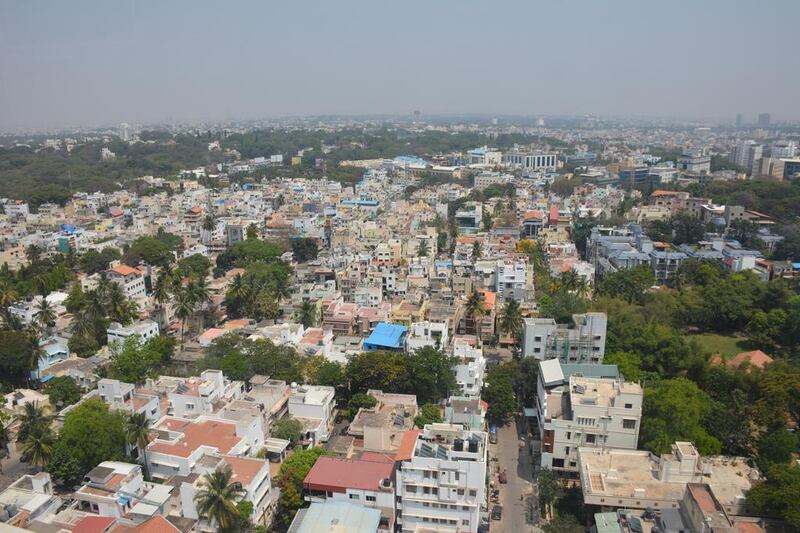It’s 10 years since I last visited Bangalore, and I’m expecting a lot to have changed. Then, I was in town for the lavish Indian wedding of a couple of friends – an inter-caste affair preceded by years of argument and tension; now, the practice is much more acceptable. In that time, partly because of its boom as India’s IT hub, the city has become one of Asia’s fastest growing; with a population of 10 million, it’s now the size of London. There’s also a new airport, and the city has been officially renamed Bengaluru.
On the flight from Abu Dhabi, the man sitting next to me, Srikant, is an Accenture consultant on his way back home from a business trip to New York, where many of his successful peers are now based. Oh, and my Indian friends whose wedding I went to? They’re now millionaires after creating a tech company on my living-room table.
So I’m almost surprised to find that Bangalore isn’t all new motorways and skyscrapers. It’s still a local city, with cows roaming the streets in some quarters, a jumbling mass of often crumbling architecture, warm and relaxed people, great food and very few tourists.
While the traffic is bad, it’s not quite as bad as everyone says, though I notice my eyes stinging from the pollution in the central areas. Still, the title of “Garden City” isn’t yet redundant: there’s a surprising amount of greenery, with some avenues of old mango trees and, when I visit, the jacaranda trees are bursting with purple blossom. And while two large areas on the eastern edge of the city – Whitefield and Electronic City – are dedicated to the IT world, this is no Palo Alto. Elsewhere in the city, small, smart business parks have simply been slotted into the existing urban fabric.
I check into the new Shangri-La Bengaluru, a slick, 20-storey block in the affluent Vasanth Nagar district, just north of the city centre. Opened last year, it’s Shangri-La’s second property in India (the other is in New Delhi), and aimed as much at the new monied local market as those from abroad. It’s the tallest building in the area, looking out over an attractive scene of relatively smart villas and the grounds of the Bangalore Palace, a bizarre copy of Windsor Castle built in the 1880s. Brown kites wheel overhead; there’s an array of rooftop bars and restaurants, a club lounge, a decadent Chi spa and reassuring, almost military-style security.
On my first morning, I head to the City Market (also known as the Krishnarajendra Market) in Gandhi Nagar, a busy central district a couple of kilometres away. I’m accompanied by a guide called Narender Kumar, a tall, distinguished-looking gentleman whose father was in the Indian army.
The Wi-Fi-equipped hotel car drops us off on a busy roundabout choked with tuk-tuks, lorries and even ox carts. Still, says Narender: “People use less horns here than in other cities in India.” Street sellers peddle their wares on the ground and from carts. Small shops sell big blocks of jaggery, whirls of betel leaves, mountains of spices, copperware and brightly coloured cones of gorgeous flower-petal powder (called kumkum, and used as dyes and in the Holi festival). At the flower market are huge piles of roses, lotus flowers and massive marigold garlands, selling for just 20 rupees (Dh1) per metre. Most of the flowers are sold in the basement, and as we enter and exit, we’re struck by the overpowering smell of a sewer, which runs beside the building, and is packed with further rubbish and cows feasting. Like so many other places in India, it’s this juxtaposition of the fragrant and the foul that’s so compelling. I tell Kumar that I’m surprised such scenes still exist in Bangalore, given the city’s newfound wealth. The market and its dense grid of streets are hopefully here to stay, he says. “This is here because people want it. They don’t want supermarkets or shopping malls. They want something local. Even the tourists, they ask for the local stuff. ”
Next, we visit the nearby Cubbon Park, which reminds me (mainly because it was built by the British in 1870) of London’s Hyde Park, with its 130 hectares of gardens, with some wild sections of long grass and mature mahogany trees, frangipani, bamboo and royal palms. There’s a bronze statue of Queen Victoria, and the smart roads through the park remind me of Delhi’s Rajpath. Surrounded by noise and traffic, the open space is now both a luxury and necessity. Various pieces of impressive colonial architecture, including the red-coloured neoclassical Karnataka High Court (Attara Kacheri) and the frighteningly imposing, neo-Dravidian Vidhana Soudha, the legislative chambers of the state government, complete the picture.
On the south-western edge of the city centre, we visit the Bull Temple (Dodda Basavana Gudi) in Basavanagudi. Up a small hill and behind a wedding hall, the temple dates from the 16th century. Inside, there’s a huge carved black granite monolith of a bull, which is associated with Shiva, the god of destruction, and known as Nandi. Tourists, along with all visitors, are allowed to visit barefoot, and walk around the atmospheric room containing the garlanded bull, which is said to be the biggest of its kind in the world. It seems to glare down at you from the left.
Back at the hotel, after a delicious masala chai in the lobby and a much-needed shower, I have dinner at Ssaffron, the Shangri-La’s signature Indian restaurant, on the rooftop. It’s trendy and grand, with a huge outdoor terrace and opulent interiors. There are sub-menus from all corners of the country, from local Konkani vegetable curries to Punjabi chicken tikka. The Sikh chef plies me with a tasting menu, which is delicious, despite dishes being served in small portions on slate, in jars and sometimes with sauces and vegetable separated. The vegetables with tomato gravy and tandoori chicken are standout.
Early the next day, Kumar takes me to another of his favourite “local” areas, “Pottery Town”, to the north-east of the city centre. Here, traditional pottery techniques survive in ramshackle studios churning out surprisingly large numbers of clay pots, ranging from decorative pieces to (relatively) eco-friendly disposable teacups. Prices are cheap, and the system is brilliantly low-tech (I almost catch my hair in an unguarded fan; the TV, family portraits and even shrines are splattered with earth, and a jumbled whiteboard behind our craftsman, Rajsheha, contains written details of all his orders). “He thinks he is the last generation to do this,” says Kumar. “Maybe after him it will go off. Children are not interested.”
In a shop opposite, a woman draws out a rangoli, which is a decorative pattern with limestone or brick powder on the ground, “to welcome the gods etc”. Narender says Karnataka is also one of the biggest producers of silk.
Next, we head to Commercial Street, packed with modern fabric and clothes stores. We stop at Woody’s, a traditional Indian cafe, for very good, cheap coffee and samosas, before exploring the surrounding streets, some of which are surprisingly historic. In between mechanics’ and jewellers’ workshops are some beautiful and decrepit old buildings, some of which seem to be falling down. I hope that one of Bangalore’s tech millionaires may be able to restore them.
rbehan@thenational.ae





